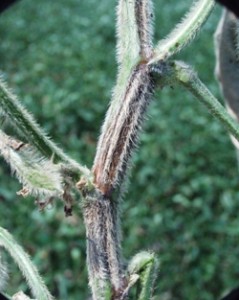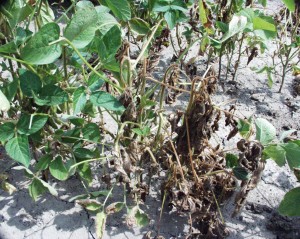In Ontario there are many root/stem diseases which cause wilting symptoms in soybeans. With the hot, dry conditions this year over much of the province some of these diseases such as stem canker, Fusarium wilt, charcoal rot have taken advantaged of the additional stress.
Fusarium wilt or blight of soybeans can affect soybeans at any stage of development and is very apparent in southwest. It is caused by the very common soil-borne fungus, Fusarium oxysporum which is different to Fusarium virguliforme which is responsible for Sudden Death Syndrome (SDS). Fusarium oxysporum causes a wilting of the soybean plant and is often misdiagnosed as Phytophthora root rot or stem canker as well. Affected plants have a wilting of the stem tips and the upper leaves are scorched. The middle and lower leaves can turn yellow or have pale (dull) yellow spots. In severe cases the leaves will dry up and drop prematurely leaving the petiole behind. The leaf symptoms are different from SDS or brown stem rot where distinct yellow speckling or spotting between the veins (interveinal chlorosis) occurs and as the disease progresses these areas become larger and in severe cases the entire area between the veins becomes brown (necrotic) and dry.
Unlike Phytopthora there also is no evidence of a stem lesion or external decay that goes above the soil line. Cutting the roots and stems lengthwise will reveal a browning of the vascular tissue and pith. This may be confused with early-season brown stem rot. Fusarium infested roots often have red, orange or white mycelium visible.
Stem Canker symptoms are often described as a general yellowing of the top leaves of the plant with dark reddish-brown sunken cankers at the nodes. The lesion may extend several inches, often on one side but does not usually extend down as far as the soil line (different then Phythophthora wilt). In severe cases however the lesion may cover the entire length of the stem but in most cases there will be a green section of stem remaining at the soil line. A cross section of the stem will reveal a slight browning at the nodes at first followed by complete disintegration of the stem in severely infected plants. The sudden wilting of the plants and the stem canker can be confused with Phytophthora root rot as well as Fusarium wilt.

Besides the yellowing of the leaves and stem lesion, stem canker can cause a “top dieback” especially later in the season. In this case, the upper four to six internodes or branches of the plant become dark brown and as the name implies the top dies (wilts). Soybean plants may become more susceptible as the plants go through physiological changes due to flowering.07cpo12a1
The fungus responsible for northern stem canker (Diaporthe phaseolorum var. caulivora) survives in crop residues and is therefore, influenced by not only rotation but tillage management practices. It is suspected the re-emergence of stem canker in the northern U.S. and Ontario is due not only to more soybeans and less tillage but possibly an increase in susceptible varieties being grown.
Charcoal rot is one disease which you may not be aware of since it only really shows up when the weather is very hot and dry and occurs predominantly in southwestern Ontario. Although the fungus responsible for charcoal rot (Macrophomina phaseolina) infects early it is not usually until late July or August for symptoms to become obvious but with an early start this year symptoms started early.

Look for tiny, round black structures (microsclerotia) produced inside and on the surface of the taproot and lower stems which often have a grayish appearance. If you split the lower stem/root, you will find black/dark streaks or staining of the tap root. Infected plants will wilt and are often stunted with yellow leaves which can be confused with drought or other wilt diseases.
Why this year? The wilt and other root rot diseases are most problematic when soybeans are under water, heat and root stress. In addition, soybean cyst nematode can further stress an already compromised plant and allow easy access for many soil-borne root pathogens. Stress can interfere with the normal activity of the plant’s root system and therefore, will affect growth and potentially increase root diseases. Stunting, overall poor growth and wilting are all symptoms of root stress. Root stress will also often resemble nutrient deficiencies.

It is important to remember every field is different and many of these diseases can occur in the same field. For example Dr. Terry Anderson (retired AAFC Pant Pathologist in Harrow) who has been graciously helping with a new GFO and CAAP funded seedling disease project found the following breakdown of fungi from two fields showing wilt symptoms in Essex county. The percentage of plants infected in field one was – Fusarium (93%) and charcoal rot (36%) and in field two Terry found Fusarium (25%), charcoal rot (25%), Phytophthora (25%), stem canker (8%) and Pythium 8%.
It is important for producers to scout their fields and identify problem fields now and to harvest. This will assist in the selection of resistant varieties if available as well as other management options. Fungicide seed treatments have been shown to reduce early infections but will not help with later season infections. Foliar fungicides may be effective for stem canker if applied before disease develops but again results have been inconsistent and they won’t help with charcoal rot or Fusarium wilt. Crop rotation with non hosts such as corn and wheat (small grains) can reduce these wilt pathogens but only to a degree since some can infect other crops and weeds as well. Reducing the amount of infested soybean residue on the soil surface is another management tool to consider. We can’t change the weather but we can minimize risk of these and other diseases from occurring in the future.